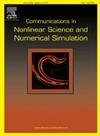Fractional order induced bifurcations in Caputo-type denatured Morris–Lecar neurons
IF 3.8
2区 数学
Q1 MATHEMATICS, APPLIED
Communications in Nonlinear Science and Numerical Simulation
Pub Date : 2025-06-07
DOI:10.1016/j.cnsns.2025.108984
引用次数: 0
Abstract
We set up a system of Caputo-type fractional differential equations for a reduced neuron model known as the denatured Morris–Lecar (dML) system. This neuron model has a structural similarity to a FitzHugh–Nagumo type system. We explore both a single-cell isolated neuron and a two-coupled dimer that can have two different coupling strategies. The main purpose of this study is to report various oscillatory phenomena (tonic spiking, mixed-mode oscillation) and bifurcations (saddle–node and Hopf) that arise with variation of the order of the fractional operator and the magnitude of the coupling strength for the coupled system. Various closed-form solutions as functions of the system parameters are established that act as the necessary and sufficient conditions for the stability of the equilibrium point. Fractional order systems induce memory effects to excitable cells, thus providing an efficient and biophysically more realistic scenario. All theoretical analyses in this study are supported by rigorous numerical simulations.
分数阶诱导caputo型变性Morris-Lecar神经元分叉
我们为一个被称为变性Morris-Lecar (dML)系统的简化神经元模型建立了一个卡普托式分数阶微分方程系统。该神经元模型与FitzHugh-Nagumo型系统具有结构相似性。我们探索单细胞分离神经元和双偶联二聚体,可以有两种不同的耦合策略。本研究的主要目的是报道随着分数算子的阶数和耦合强度的大小的变化而产生的各种振荡现象(强音尖峰、混合模式振荡)和分岔(鞍节点和Hopf)。建立了系统参数函数的各种闭式解,作为平衡点稳定的充分必要条件。分数阶系统诱导可兴奋细胞的记忆效应,从而提供了一个有效的和生物物理上更现实的场景。本研究的所有理论分析都得到了严格的数值模拟的支持。
本文章由计算机程序翻译,如有差异,请以英文原文为准。
求助全文
约1分钟内获得全文
求助全文
来源期刊

Communications in Nonlinear Science and Numerical Simulation
MATHEMATICS, APPLIED-MATHEMATICS, INTERDISCIPLINARY APPLICATIONS
CiteScore
6.80
自引率
7.70%
发文量
378
审稿时长
78 days
期刊介绍:
The journal publishes original research findings on experimental observation, mathematical modeling, theoretical analysis and numerical simulation, for more accurate description, better prediction or novel application, of nonlinear phenomena in science and engineering. It offers a venue for researchers to make rapid exchange of ideas and techniques in nonlinear science and complexity.
The submission of manuscripts with cross-disciplinary approaches in nonlinear science and complexity is particularly encouraged.
Topics of interest:
Nonlinear differential or delay equations, Lie group analysis and asymptotic methods, Discontinuous systems, Fractals, Fractional calculus and dynamics, Nonlinear effects in quantum mechanics, Nonlinear stochastic processes, Experimental nonlinear science, Time-series and signal analysis, Computational methods and simulations in nonlinear science and engineering, Control of dynamical systems, Synchronization, Lyapunov analysis, High-dimensional chaos and turbulence, Chaos in Hamiltonian systems, Integrable systems and solitons, Collective behavior in many-body systems, Biological physics and networks, Nonlinear mechanical systems, Complex systems and complexity.
No length limitation for contributions is set, but only concisely written manuscripts are published. Brief papers are published on the basis of Rapid Communications. Discussions of previously published papers are welcome.
 求助内容:
求助内容: 应助结果提醒方式:
应助结果提醒方式:


